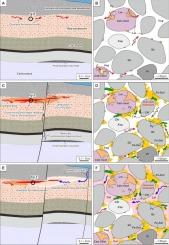鄂尔多斯盆地井川砂岩型铀矿床铀源与成矿过程新认识——来自地质、碳酸盐结构和地球化学的证据
IF 3.6
2区 地球科学
Q1 GEOLOGY
引用次数: 0
摘要
世界级的京川砂岩型铀矿床位于中国鄂尔多斯盆地漯河组下白垩统灰色砂岩地层中,矿体异常厚(3 ~ 280 m),空间分布广泛(约2000平方公里),矿石品位较高(4.3 ~ 17.4 kg/m2),铀矿储量异常高。铀矿化优先赋存于还原灰色砂岩带,呈现钙质、铁质和硅质胶结。相反,在灰色砂岩的中下部广泛存在的红色层通常是不含铀的。盆地砂岩中的铀成矿作用普遍归因于氧化还原过程;然而,所涉及的精确机制和详细过程仍未确定。碳酸盐的存在贯穿整个铀矿化过程,有效地记录了成矿流体、矿化过程和沉淀条件的性质。本研究将详细的岩石学观察与原位地球化学分析(LA-ICP-MS)相结合,以限制这一特殊铀矿床的成因。确定了三种不同类型的碳酸盐:(1)高圆度的白云岩和方解石碎屑(成矿前阶段;碎屑颗粒;1型);(2)壳状、自面体微晶或胶结的含铁白云岩(矿期);与铀矿化有关的空间和遗传;2型);(3)充填孔隙的亮晶方解石(矿后阶段);在表生流体渗透过程中形成;3)类型。2型碳酸盐的LA-ICP-MS分析显示,U含量升高,富U包裹体普遍存在,证实了它们与U矿化的直接联系。此外,2型碳酸盐岩中总稀土元素(ƩREE)和磷(P)含量升高,表明其为氧化性盆地流体和还原性含油气流体的混合。1型和2型碳酸盐具有相似的球粒陨石归一化稀土模式和Th/U比值,表明后者继承了前者的地球化学特征。地球化学特征的相似性表明,1型碳酸盐碎屑可能是成矿流体中铀和其他金属的来源。3型岩石地球化学特征明显,表明流体来源不同,形成过程中地球化学条件发生了变化。地球化学(Y/Ho比值、δCe值和其他微量元素数据)和矿物学证据表明,铀矿化可能来源于盆内地层含铀碳酸盐岩碎屑。我们认为,氧化盆地流体与这些碳酸盐碎屑的长期相互作用导致成矿流体中U、Fe、Mg、Ca等元素的逐渐富集。这些氧化性富铀流体与还原性含油气流体的混合作用,沿着深部断裂向上运移,引发氧化还原反应,导致含铁白云岩大面积沉淀,形成了靖川铀矿床。成矿后阶段以贫铀方解石沉积为标志,反映了成矿热液活动减弱和大气水的涌入。本文章由计算机程序翻译,如有差异,请以英文原文为准。

New insights into uranium source and mineralization process of the world-class jingchuan sandstone-hosted uranium deposit, ordos basin, China: Evidence from geology, carbonate textures and geochemistry
The world-class Jingchuan sandstone-type uranium deposit is situated in the Lower Cretaceous gray sandstone strata of the Luohe Formation, Ordos Basin, China, distinguished by its exceptionally thick orebodies (3–280 m) and extensive spatial distribution (about 2000 square kilometers), with relatively high ore grades of 4.3–17.4 kg/m2, suggesting exceptionally high uranium reserves. Uranium mineralization is preferentially hosted within reduced gray sandstone zones that exhibit calcareous, ferruginous, and siliceous cementation. In contrast, the extensive red beds, present in the middle and lower parts of the gray sandstones, are generally barren of uranium. The uranium mineralization in basin sandstones is widely attributed to redox processes; however, the precise mechanisms and detailed processes involved remain undetermined. The presence of carbonates persists throughout the uranium mineralization process, effectively recording the properties of ore-forming fluids, mineralization processes, and precipitation conditions. This study integrates detailed petrographic observations with in situ geochemical analyses (LA-ICP-MS) to constrain the genesis of this exceptional uranium deposit. Three distinct types of carbonates have been identified: (1) highly rounded dolomite and calcite clasts (pre-ore stage; detrital grains; Type 1); (2) shell-like, euhedral microcrystalline, or cement-bound Fe-bearing dolomite (ore stage; spatially and genetically associated with uranium mineralization; Type 2); and (3) pore-filling sparry calcite (post-ore stage; formed during supergene fluid infiltration; Type 3). LA-ICP-MS analyses of the ore-stage carbonates (Type 2) reveal elevated U contents and prevalent existence of U-rich mineral inclusions, corroborating their direct association with U mineralization. Additionally, elevated total rare earth element (ƩREE) and phosphorus (P) concentrations in the Type 2 carbonates indicate mixture of oxidizing basinal fluid and reducing hydrocarbon-bearing fluid. Type 1 and Type 2 carbonates share similar chondrite-normalized REE patterns and Th/U ratios, indicating that the latter inherited its geochemical signature from the former. The similarity in geochemical signatures suggests that Type 1 carbonate clasts may have served as a source of uranium and other metals for the ore-forming fluids. In contrast, Type 3 shows a distinct geochemical signature, indicative of a different fluid source and a shift in the geochemical conditions during its formation. The combined geochemical (Y/Ho ratios, δCe values, and other trace element data) and mineralogical evidence suggest that the uranium mineralization may have originated from intra-basinal stratigraphic uranium-bearing carbonate clasts. We propose that prolonged interaction between oxidizing basinal fluids and these carbonate clasts resulted in the progressive enrichment of U, Fe, Mg, Ca, and other elements within the ore-forming fluids. Subsequent mixing of these oxidizing, uranium-rich fluids with reducing, hydrocarbon-bearing fluids, migrating upward along deep-seated faults, triggered redox reactions, leading to the widespread precipitation of Fe-bearing dolomite and the formation of the Jingchuan uranium deposit. The post-mineralization stage, marked by the deposition of uranium-poor calcite, reflects a waning of mineralizing hydrothermal activity and the influx of meteoric water into the system.
求助全文
通过发布文献求助,成功后即可免费获取论文全文。
去求助
来源期刊

Ore Geology Reviews
地学-地质学
CiteScore
6.50
自引率
27.30%
发文量
546
审稿时长
22.9 weeks
期刊介绍:
Ore Geology Reviews aims to familiarize all earth scientists with recent advances in a number of interconnected disciplines related to the study of, and search for, ore deposits. The reviews range from brief to longer contributions, but the journal preferentially publishes manuscripts that fill the niche between the commonly shorter journal articles and the comprehensive book coverages, and thus has a special appeal to many authors and readers.
 求助内容:
求助内容: 应助结果提醒方式:
应助结果提醒方式:


